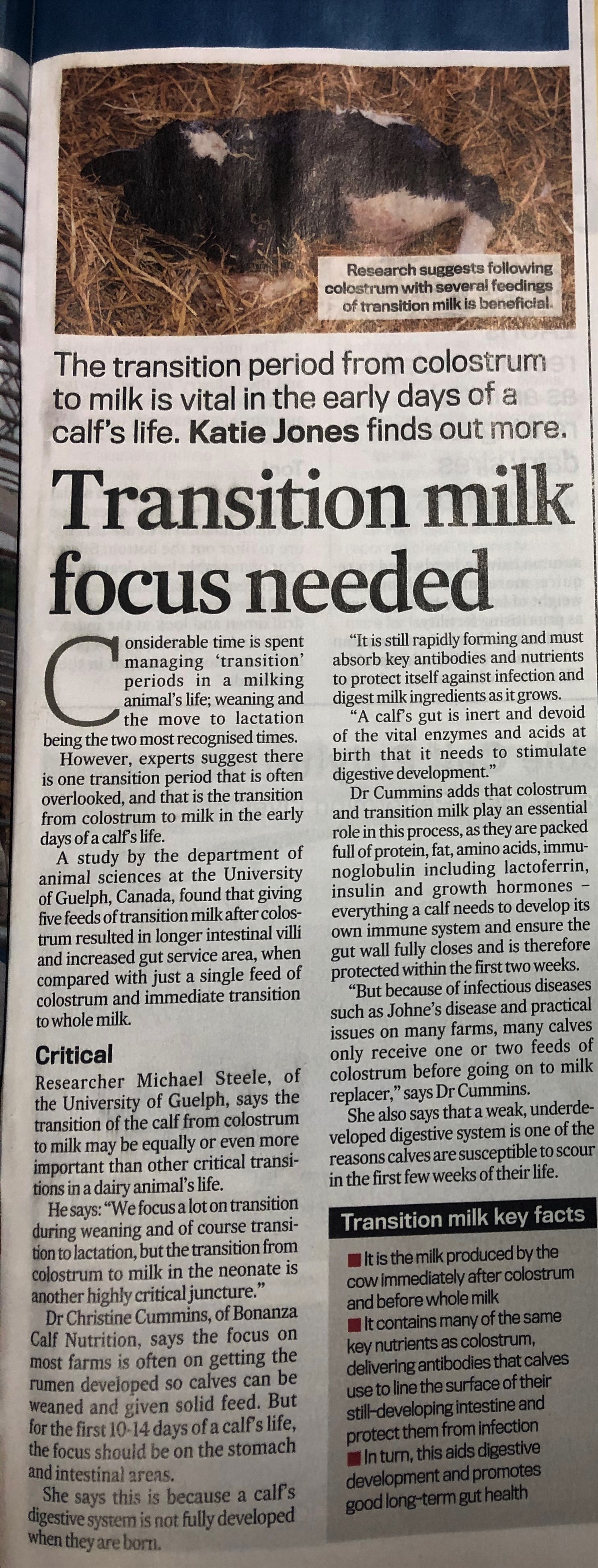Are We Underestimating the Importance of Transition Milk?
We are all familiar with the need to provide our animals with the most effective nutrition, in order to maximise their health, well-being and productivity.
As dairy farmers, we recognise that our herds need different types of nutrition throughout their life cycle. We know that the transition between these phases is important if we want our cows to produce milk as efficiently as possible.
It’s why we spend a lot of time and effort on the weaning period, and the transition to lactation.
But there is one transition period that’s often overlooked.
The transition from colostrum to milk in the early days of a calf’s life
Traditionally, the focus on the majority of farms is on getting the rumen developed so that calves can be weaned and given solid feed. But for the first ten to fourteen days of a calf’s life, the focus should on the stomach and intestinal areas.
That’s because a calf’s digestive system is not fully developed when they are born. It’s still rapidly forming and must absorb key antibodies and nutrients to protect itself against infection and digest milk ingredients as it grows.
A calf’s gut is inert and devoid of the vital enzymes and acids at birth that it needs to stimulate digestive development.
Colostrum – and transition milk – play an essential role in this process, as they’re packed full of protein, fat, amino acids, Immunoglobulin (IgB) including lactoferrin, insulin and growth hormones – everything a calf needs to develop its own immune system and ensure the gut wall fully closes, and therefore protected, within the first two weeks.
But, as Dr Christine Cummins of Bonanza Calf Nutrition notes, “Because of infectious diseases such as Johne’s disease and practical issues on many farms, many calves only receive one or two feeds of colostrum before going on to milk replacer.”
A weak, underdeveloped digestive system is one of the reasons calves are susceptible to scour in the first few weeks of their life. The cells in their small intestine that they were born with are being replaced by new ones – cells which don’t have the protection of surface antibodies from colostrum. This leaves them susceptible to attack by pathogens and digestive abrasion, and is primary cause of scour amongst calves.
Despite this, for many farmers the risk of diseases such as Johne’s disease and Mycoplasma, which are transferred through milk, is too high, and that risk outweighs the benefits on health and performance in heifers if they’re given colostrum for longer. They may also not have enough transition milk to feed every calf for ten days.
Transition Milk Replacement bridges that gap.
Transition Milk contains many of the same key nutrients as colostrum, delivering the essential antibodies that calves use to line the surface of their still developing intestine and protect them from infection. In turn, this aids digestive development and promotes good, long-term gut health.
A study by the Department of Animal Sciences at The University of Guelph found that feeding either transition milk or colostrum resulted in longer intestinal villi and increased gut service area, when compared with just a single feed of colostrum and immediate transition to whole milk.
Supporting digestive development and promoting good gut health
Because transition milk, or transition milk replacement formulas, contain many of those same vital nutrients and antibodies as colostrum, it can be used to give calves the best start in life and ensure heifers go on to be highly productive.
It contains surface antibodies – as replacements to the ones found in colostrum – that line the small intestine to help calves establish their immune system and protect their intestinal health.
And by protecting a calf’s digestive system, it helps to eliminate cases of scour on the farm while also promoting long-term gut health. Calves find it difficult to digest certain fats for the first week of their life, and Vitamin C production can take two weeks to begin. Transition Milk provides the nutrients they need to kick-start these processes and provide a solid foundation for future development.
As Dr Christine Cummins says, “by focusing on the digestive and gut health of your calves in the first weeks of their lives, you’ll see a far greater return in productivity than any feeding regime that calves are put on later.”
Contact us
Bonanza Calf Nutrition
Producers of the renowned Shine range of milk replacers for calves and lambs.
© 2017 Bonanza Calf Nutrition Ltd.
FIND US

